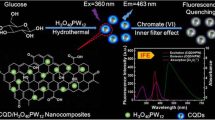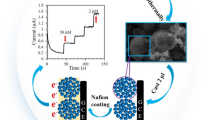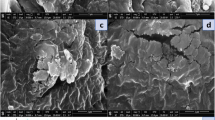Abstract
A method is described for extracting and detecting the fluorescent reaction product (2′,7′-dichlorofluorescein, DCF) that is formed by reaction of reactive oxygen species (ROS) with dichlorodihydrofluorescein diacetate (DCFH-DA). DCF is extracted by using porous polyaniline nanotubes (PPN) which have a large specific surface and pore volume which favor the adsorption capacity. Additional attractive features include an appropriate pore size distribution, hydrophobic surface, and electron-attracting groups which contribute to DCF adsorption. A variety of methods was applied to characterize the morphology of PPN. Under optimal conditions and by performing DCF in 0.08–1.0 μM concentrations, the correlation coefficient of the calibration plot is 0.999. The limits of detection for standard DCF solutions is 20 nM. Compared with commercial sorbents for solid-phase extraction (SPE) such as commercially available carbon or Welchrom® C18, the use of the new sorbent results in better retraction recovery (92%) and longer reuse times (30 times). Doxorubicin and X-ray radiation were used to externally stimulate the ROS production in HepG2 and Hela cells. ROS was stabled by DCFH-DA and quantified by DCF. Following SPE, DCF was detected by HPLC and the concentration ROS was calculated.

ᅟ








Similar content being viewed by others
References
Gabbita SP, Robinson KA, Stewart CA, Floyd RA, Hensley K (2000) Redox regulatory mechanisms of cellular signal transduction. Arch Biochem Biophys 376(1):1–13
Li L, Li Q, Chen P, Li Z, Chen Z, Tang B (2016) Consecutive gated injection-based microchip electrophoresis for simultaneous quantitation of superoxide anion and nitric oxide in single PC-12 cells. Anal Chem 88(1):930–936
Koszegi T, Sali N, Raknic M, Horvath-Szalai Z, Csepregi R, Koncic MZ, Papp N, Poor M (2017) A novel luminol-based enhanced chemiluminescence antioxidant capacity microplate assay for use in different biological matrices. J Pharmacol Toxicol Methods 88:153–159
Hananya N, Green O, Blau R, Satchi-Fainaro R, Shabat D (2017) A highly efficient chemiluminescence probe for the detection of singlet oxygen in living cells. Angew Chem Int Ed 56(39):11793–11796
Martino T, Kudrolli TA, Kumar B, Salviano I, Mencalha A, Coelho MGP, Justo G, Costa PPR, Sabino KCC, Lupold SE (2018) The orally active pterocarpanquinone LQB-118 exhibits cytotoxicity in prostate cancer cell and tumor models through cellular redox stress. Prostate 78(2):140–151
Jiang L, Wang L, Chen L, Cai GH, Ren QY, Chen JZ, Shi HJ, Xie YH (2015) As2O3 induces apoptosis in human hepatocellular carcinoma HepG2 cells through a ROS-mediated mitochondrial pathway and activation of caspases. Int J Clin Exp Med 8(2):2190–2196
Mehanna C, Baudouin C, Brignole-Baudouin F (2011) Spectrofluorometry assays for oxidative stress and apoptosis, with cell viability on the same microplates: a multiparametric analysis and quality control. Toxicol in Vitro 25(5):1089–1096
Qu LL, Li DW, Qin LX, M J FJS, Long YT (2013) Selective and sensitive detection of intracellular O2 •− using Au NPs/ cytochrome c as SERS nanosensors. Anal Chem 85(20):9549–9555
Vásquez-Vivar J, Hogg N, Pritchard KA, Martasek P, Kalyanaraman B (1997) Superoxide anion formation from lucigenin: an electron spin resonance spin-trapping study. FEBS Lett 403(2):127–130
Suzen S, Gurer-Orhan H, Saso L (2017) Detection of reactive oxygen and nitrogen species by electron paramagnetic resonance (EPR) technique. Molecules 22(1):181. https://doi.org/10.3390/molecules22010181
Dikalov SI, Polienko YF, Kirilyuk I (2017) Electron paramagnetic resonance measurements of reactive oxygen species by cyclic hydroxylamine spin probes. Antioxid Redox Signal 28(15):1365–1377
Li DW, Sun JJ, Gan ZF, Chen HY, Dan G (2018) Reaction-based SERS nanosensor for monitoring and imaging the endogenous hypochlorous acid in living cells. Anal Chim Acta 1018:104–110
Kwon JA, Jin CM, Shin Y, Kim HY, Kim Y, Kang T, Choi I (2018) Tunable plasmonic cavity for label-free detection of small molecules. ACS Appl Mater Interfaces 10(15):13226–13235
Fu Y, Huang D, Li C, Zou L, Ye B (2018) Graphene blended with SnO2 and Pd-Pt nanocages for sensitive non-enzymatic electrochemical detection of H2O2 released from living cells. Anal Chim Acta 1014:10–18
Wu P, Cai Z, Chen J, Zhang H, Cai C (2011) Electrochemical measurement of the flux of hydrogen peroxide releasing from RAW 264.7 macrophage cells based on enzyme-attapulgite clay nanohybrids. Biosens Bioelectron 26(10):4012–4017
Sun Y, Yin X, Ling Y, Fang Z (2005) Determination of reactive oxygen species in single human erythrocytes using microfluidic chip electrophoresis. Anal Bioanal Chem 382(7):1472–1476
Wang MQ, Ye C, Bao SJ, Xu MW (2017) Controlled synthesis of Mn3(PO4)2 hollow spheres as biomimetic enzymes for selective detection of superoxide anions released by living cells. Microchim Acta 184(4):1177–1184
Chen YC, Hsu JH, Hsu YK (2018) Branched silver nanowires on fluorine-doped tin oxide glass for simultaneous amperometric detection of H2O2 and of 4-aminothiophenol by SERS. Microchim Acta 185(2):106. https://doi.org/10.1007/s00604-017-2625-1
Wu HY, Sun P, Feng HQ, Zhou HX, Wang RX, Liang YD, Lu JF, Zhu WD, Zhang J, Fang J (2012) Reactive oxygen species in a non-thermal plasma microjet and water system: generation, conversion, and contributions to bacteria inactivation-an analysis by electron spin resonance spectroscopy. Plasma Process Polym 9(4):417–424
Chen L, Yamane S, Mizukado J, Suzuki Y, Kutsuna S, Uchimaru T, Suda H (2015) ESR study of singlet oxygen generation and its behavior during the photo-oxidation of P3HT insolution. Chem Phys Lett 624:87–92
Candish E, Wirth HJ, Gooley AA, Shellie RA, Hilder EF (2015) Characterization of large surface area polymer monoliths and their utility for rapid, selective solid phase extraction for improved sample clean up. J Chromatogr A 1410:9–18
Cui KY, Lin YY, Zhou X, Li SC, Liu H, Zeng F, Zhu F, Ouyang GF, Zeng ZX (2015) Comparison of sample pretreatment methods for the determination of multiple phytohormones in plant samples by liquid chromatography–electrospray ionization-tandem mass spectrometry. Microchem J 121:25–31
Candish E, Khodabandeh A, Gaborieau M, Rodemann T, Shellie RA, Gooley AA, Hilder EF (2017) Poly(ethylene glycol) functionalization of monolithic poly(divinyl benzene) for improved miniaturized solid phase extraction of protein-rich samples. Anal Bioanal Chem 409(8):2189–2199
He LJ, Cui WH, Wang YL, Zhao WJ, Xiang GQ, Jiang XM, Mao P, He J, Zhang SS (2017) Polymeric ionic liquid based on magnetic materials fabricated through layer-by-layer assembly as adsorbents for extraction of pesticides. J Chromatogr A 1522:9–15
Li L, Li G, Wei H, Chen J, Sun J, Chen Y, Xie B, Wang B, Li C, Tian B, Wang F (2015) The endoplasmic reticulum stress response is associated with insulin resistance-mediated drug resistance in HepG2 cells. Neoplasma 62(2):180–190
Wang Y (2018) Preparation and application of polyaniline nanofibers: an overview. Polym Int 67(6):650–669
Ock IW, Choi JW, Jeong HM, Kang JK (2018) Synthesis of pseudocapacitive polymer chain anode and subnanoscale metal oxide cathode for aqueous hybrid capacitors enabling high energy and power densities along with long cycle life. Adv Energy Mater 8(10):1702895. https://doi.org/10.1002/aenm.201702895
Zhu Y, Murali S, Stoller MD, Ganesh KJ, Cai W, Ferreira PJ, Pirkle A, Wallace RM, Cychosz KA, Thommes M, Su D, Stach EA, Ruoff RS (2011) Carbon-based supercapacitors produced by activation of graphene. Science 332(6037):1537–1541
Xu S, Lv Y, Zeng X, Cao D (2017) ZIF-derived nitrogen-doped porous carbons as highly efficient adsorbents for removal of organic compounds from wastewater. Chem Eng J 323:502–511
Wang J, Tan X, Yang Q, Zeng X, Zhou Y, Luo W, Lin X, Song L, Cai J, Wang T, Wu X (2016) Inhibition of autophagy promotes apoptosis and enhances anticancer efficacy of Doxorubicin via augmented ROS generation in prostate cancer cells. Int J Biochem Cell Biol 77:80–90
Nitiss KC, Nitiss JL (2014) Twisting and ironing: doxorubicin cardiotoxicity by mitochondrial DNA damage. Clin Cancer Res 20(18):4737–4739
Zhao L, Qi Y, Xu L, Tao X, Han X, Yin L, Peng J (2018) MicroRNA-140-5p aggravates doxorubicin-induced cardiotoxicity by promoting myocardial oxidative stress via targeting Nrf2 and Sirt2. Redox Biol 15:284–296
Ku T, Woloschak GE (2017) Future directions of intraoperative radiation therapy: a brief review. Front Oncol 7:300. https://doi.org/10.3389/fonc.2017.00300
Zhao J, Guo Z, Pei S, Song L, Wang C, Ma J, Jin L, Ma Y, He R, Zhong J, Ma Y, Zhang H (2017) pATM and γH2AX are effective radiation biomarkers in assessing the radiosensitivity of 12C6+ in human tumor cells. Cancer Cell Int 17:49. https://doi.org/10.1186/s12935-017-0419-5
Acknowledgements
This work was supported by the National Natural Science Foundation of China (21575149, 21505146 and 21575148).
Author information
Authors and Affiliations
Corresponding authors
Ethics declarations
The author(s) declare that they have no competing interests.
Electronic supplementary material
ESM 1
(DOC 905 kb)
Rights and permissions
About this article
Cite this article
Niu, P., Li, F., Liang, X. et al. A porous polyaniline nanotube sorbent for solid-phase extraction of the fluorescent reaction product of reactive oxygen species in cells, and its determination by HPLC. Microchim Acta 185, 468 (2018). https://doi.org/10.1007/s00604-018-3000-6
Received:
Accepted:
Published:
DOI: https://doi.org/10.1007/s00604-018-3000-6




